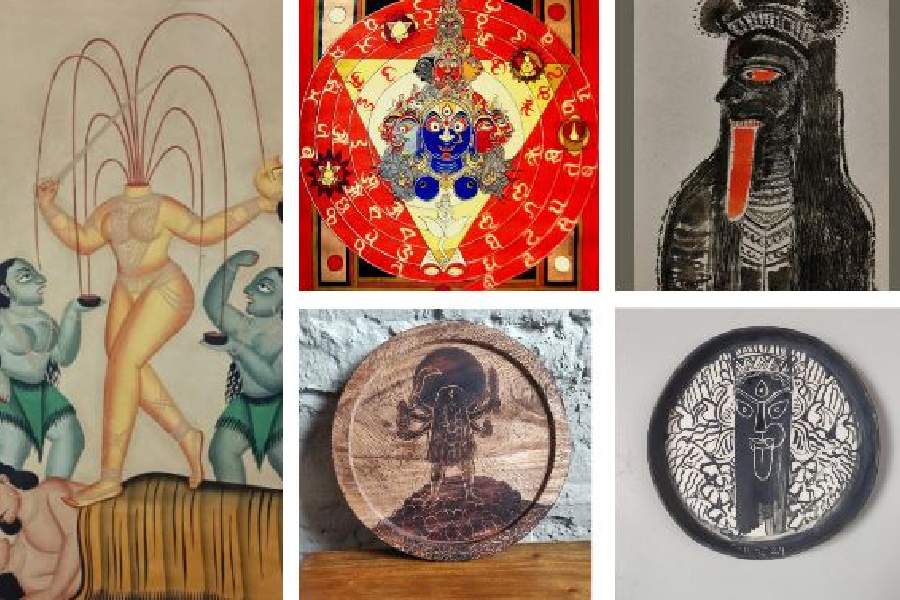The goddess Kali is everything, and more. She is time — kaal — and the destroyer of time. She is also kaalo, dark, and naked, above the qualities of colour and light and the features of body and form. She is destroyer and preserver. She is endless.
But in her finite form, in which humans imagine her, she is various and always spectacular. Seekers, singers, poets, madmen — sometimes these categories overlap — and devotees of every description think of Kali in their own way: the goddess is terrible, tender, mother, daughter, demon-slayer, slayer of the human ego, feminist icon, devoted wife, on a rampage, the calm of mind, vital energy, arrested force, too vast to comprehend, yet compelling as an image.
Calcutta — or Kolikata, or Kolkata, whichever name you call the city by — and Bengal have a special relationship with Kali. The city may or may not got its name from Kali, but does get much of its spirit from the goddess. The Kalighat temple draws thousands of devotees every day. Kali is the presiding deity of the city.
It is apt that the city is holding an art exhibition on the goddess. “KAAL-E - Embodying the Eternal: The Many Faces of Goddess Kali” started on Saturday (July 27) at AranyaBari in Jodhpur Park. On show are the works of 25 artists.
The exhibition explores the diversity of Kali’s representations across Bengal’s cultural and artistic landscapes. It brings together traditional and contemporary forms that celebrate Kali’s complex symbolism.
Kali’s face in the traditional wooden Gomira masks from north Bengal that dancers wear is stark, stylised and powerful with bold, heightened features.
Gomira performances differ; a Kali — or Chamunda (another form of Kali) — mask is worn in a ritual dance by Rajbangshi and other communities. Kali has been present in local traditions and cultures beyond mainstream Hinduism. Some feel her origins lie there.
Small and intricate shola figures of Kali are part of the show. So are Santhal patachitras that are delicate in their colours.
In more contemporary forms Kali may look like pop art. One of Sumantra Mukherjee’s paintings shows Kali as a young woman with a punk hairstyle, a CCTV camera fitted to her head and a scorpion, which is seen on a traditional idol’s foot, worn like an accessory across the forehead, though the garland of human heads remains in place around the neck. Her red mouth is parted and a small yellow object rests on her tongue. Kali is also counter-culture.
Artist Nabendu Sengupta, whose ceramic portraits of Kali are on display and who works closely with AranyaBari, has put the show together with interdisciplinary artist Manas Acharya.
Sengupta points at a few personal factors behind the exhibition. AranyaBari, a craft and textile store that intends to function as a creative space for the arts, had one of its early, much-loved stores in Kalighat.
Sengupta grew up in Naihati, about 40km from Calcutta, which is famous for the revered Boro Ma, the more than 20 feet tall, black, ferocious Kali, but is home to several other spectacular, if not so famous, idols.
“We were moved as children by the making of the idol. First the straw frame, then the hair is added. Then on the idol the play of red on the ink black exterior,” smiles Sengupta.
The eyes would be red, the protruding tongue red, the lips red, the blood stains on the sides of the mouth red, the lines on her neck red, the palms red, the feet painted red, not to mention the bloodbath that Kali is embodying. Other than the garland of bleeding heads, she may wear a skirt made of severed hands and hold a severed head, the symbol of slain human ego, in one of her four arms.
“Previously, a yellow line would also be drawn with the red in her eyes against the black,” says Sengupta. “On her navel is a triangle. On her foot is a scorpion, painted red.”
Kali provokes the artist’s imagination.
In Bengal the worship of Dakshina Kali, one of the dominant forms of the goddess with the face turned towards the right (dakshin), was popularised by Krishnananda Agamvagish, about four centuries ago. But Kali’s forms in Bengal vary so much, reminds Sengupta again. He mentions Anandamayee Kali, who sits on top of Shiva, or Rajaballabhi Kali, whose complexion is white.
The artists at the exhibition not only imagine Kali similarly in many forms, but also in many colours. Anwar Chitrakar’s Kali has a dark face, but light torso. She is sitting. Kali as Chhinnamasta, who has beheaded herself and drinking her own blood atop the couple Rati and Kamdev, is drawn by Anwar traditionally, but with a light complexion.
Chhandok Majumdar’s Kali is black with eyes and tongue like red gashes. A brilliant turquoise patina colours Susmita Gupta’s Kali. The shola Kali figures are white.
Tamal Bhattacharya’s Kali is black like the night and dazzling. Alok Halder’s wooden plates show a Kali dark like a storm. Sambaran Das’s Kali is a tantalising black and white figure, out of a graphic action sequence.
Kali sets the imagination free.
“I believe Kali is a very powerful woman. She is not content to stand one step behind a man or sit coyly on his lap. She is in control, of her body, of her feelings and what she wants to do with them,” says Chandoni Basu, proprietor, AranyaBari.
“She has this special ability to be beautiful and ominous at the same time. And above all she is an artist’s delight,” says Basu.
“I am glad that the first art show we are hosting is going to be on Kali,” she says, adding that Sengupta and Acharya were confident that art needed to be viewed in natural light and not always on stark white walls.
The show will be held till August 27. It will be closed on Mondays.











